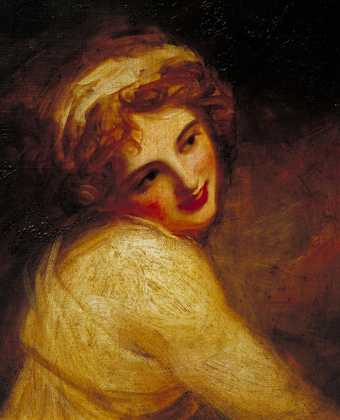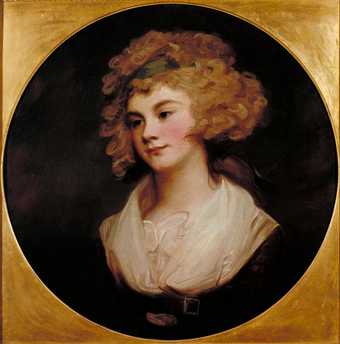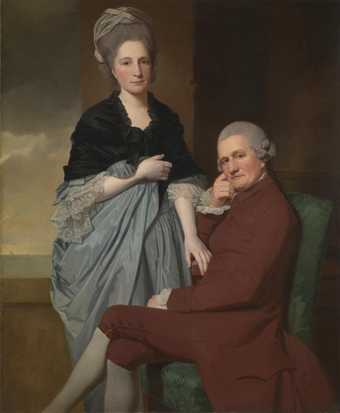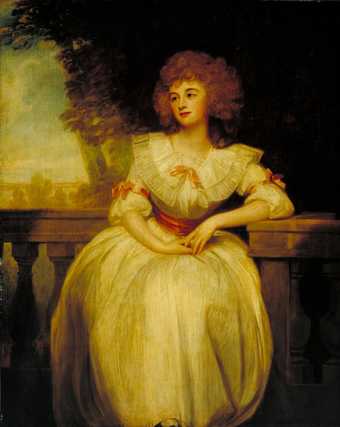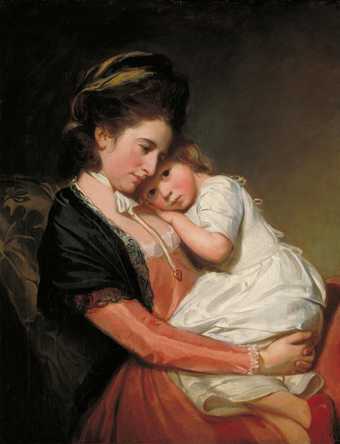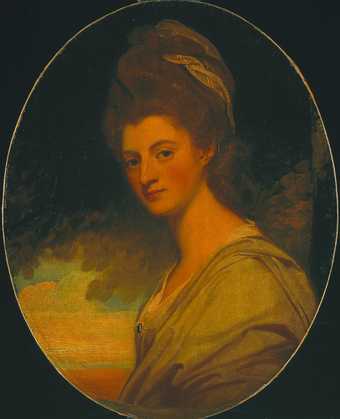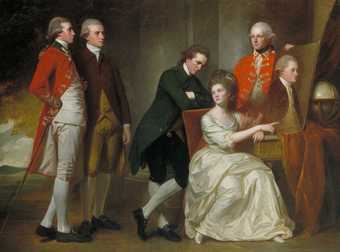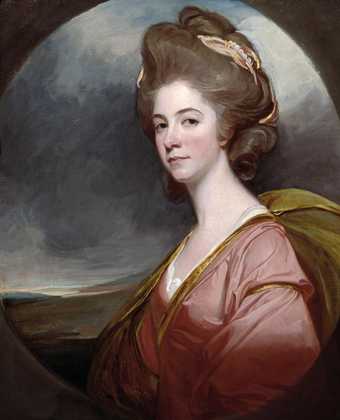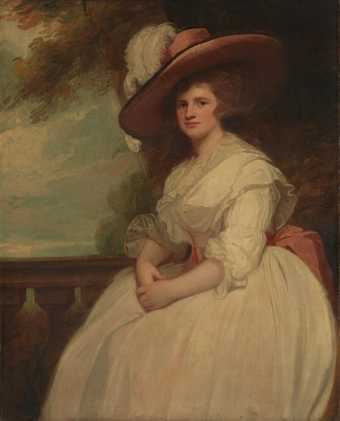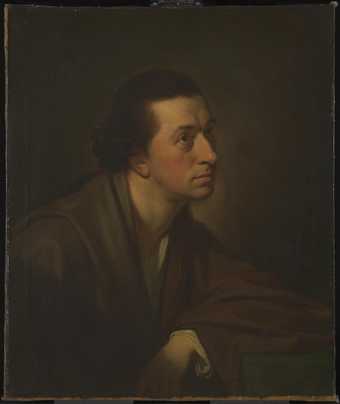
In Tate Britain
- Artist
- George Romney 1734–1802
- Medium
- Oil paint on canvas
- Dimensions
- Support: 533 × 495 mm
frame: 717 × 685 × 90 mm - Collection
- Tate
- Acquisition
- Bequeathed by Lady Wharton 1945
- Reference
- N05591
Summary
This unfinished, life-size sketch in oil paint represents the seventeen year-old Emma Hart (baptised as Emy Lyon, also known as Emily Lyon and Emma Lyon, later Lady Hamilton; 1765–1815) in the character of the sorceress Circe from Greek mythology. Hart wears loose white drapery exposing her throat and chest, her auburn hair piled ‘high’ in a top-knot whipped by the wind, with loose hair trailing over her bare shoulder. She stares directly outwards, her face tilted slightly downwards and her mouth opened a little in a pronounced pout. Her features are fully realised in paint, while her costume and hair are loosely brushed in and the background is very roughly sketched with apparently arbitrary brush strokes of earth colour animating the canvas; the several long, vertical strokes of white paint on the right indicate in a very approximate way the intended position of the sitter's left arm. The rough surface of the hessian fabric used as the painting’s support breaks up many of these brushstrokes, enhancing the impression of swift, almost reckless execution. This painting was among the first of Romney’s numerous portraits of Emma Hart painted over the succeeding nine years, which often represent her as characters from myth and literature. These have become the works for which Romney is best known, as Emma Hart’s complex and extremely public love life (most famously her later romance with Admiral Nelson while married to the aged Sir William Hamilton) has been mythologised by numerous biographies and historical studies.
The painting arose in connection with the sustained series of sittings Hart (referred to in Romney’s notes as ‘Mrs Hart’) made to Romney in his house in Cavendish Square, London, in the summer of 1782. Hart had become the mistress of the aristocratic politician and collector Charles Greville (1749–1809) in April of that year, moving into his home at Edgware Row, Paddington, and had already sat to Romney for a portrait (later engraved as ‘Nature’). The further sittings in the summer resulted in this painting and a closely-related full-length portrait of Hart as Circe (Waddesdon, The Rothschild Collection [Rothschild Family Trust]). The latter shows her holding in her right hand a long wand pointed towards the ground and with her left arm raised straight upwards, fingers outstretched as if casting a spell or invoking spirits. The art historian Alex Kidson, the leading modern authority on Romney, interprets this picture as a ‘study’ for the full-length painting, prepared spontaneously from the life and marking a ‘charged confrontation between artist and model’ (Kidson 2002, p.167). Hart was from a humble provincial background but was also a famously sensual beauty, already an unmarried mother (she had given birth to her daughter, in April 1782) and now swiftly installed as the lover of a wealthy older man who was not the father of that child. Romney was an established artist, but ‘moody and introverted’ according to Kidson, who posits the painting as marking a ‘decisive, intoxicating moment’ in which ‘the difference between creative and routine portraiture crystallised in his mind, and where the full expressive potential of the rapid sketch, immediate and poetic, became manifest to him’ (Kidson 2002, p.169). Whatever the psychological import of these encounters between artist and model, the resulting paintings were celebrated by contemporaries and helped enhance Romney’s reputation as an artist and Hart’s reputation as a highly sexualised beauty.
Further reading
Alex Kidson, George Romney 1734–1802, exhibition catalogue, National Portrait Gallery, London 2002, pp.167–9.
Martin Myrone
October 2013
Does this text contain inaccurate information or language that you feel we should improve or change? We would like to hear from you.
Display caption
In Greek mythology, Circe is a powerful sorceress best known for transforming her enemies into animals. This unfinished sketch is one of George Romney’s first portraits of Emma Hart, who quickly became his favourite model. His decision to paint the 17-year-old Hart as an enchantress is telling. It marked the beginning of her highly theatrical public persona and immediately signalled her sexual allure to 18th-century viewers. Such images helped raise both Romney’s reputation as a painter and Hart’s as a sensual beauty. From a working-class background, Hart’s personal fortunes rested on her celebrity.
Gallery label, April 2023
Does this text contain inaccurate information or language that you feel we should improve or change? We would like to hear from you.
Catalogue entry
George Romney 1734–1802
Emma Hart as Circe
c.1782
Oil paint on canvas
533 x 495 mm
Bequeathed by Lady Wharton 1945
N05591
Ownership history
Reportedly given by the artist to John Boydell (1720–1804), London … with John Newington Hughes (1778?–1848), Maidstone, by 1848; his sale, Christie’s, London, 14 April 1848, lot 105, bought by ‘King’ for 86 guineas, apparently for Lord Charles Vere Townshend (1785–1853), London; his sale, Christie’s, London, 13 May 1854 (44), bought by Henry Labouchère (1798–1869), later the 1st Baron Taunton, London; bequeathed to his second wife, Lady Mary Howard (1823–1892), London; by descent to his daughter by his first wife, Mina Frances (Labouchère) (died 1917), wife of Major-General Sir Arthur Ellis (1837–1907), Windsor and London; passing in 1908 to their daughter Dorothy (died 1944), wife of Charles, 8th Baron Wharton (1876–1934), Halswell, Somerset; by whom bequeathed to the National Gallery in 1945; transferred to the Tate Gallery in 1951.
Exhibition history
1848
British Institution, London, June 1848 (168; as ‘Portrait of Lady Hamilton, the original study for Cassandra’ lent by Lord Charles Townshend).
1868
National Exhibition of Works of Art, Leeds General Infirmary, Leeds, 19 May–31 October 1868 (1110; as ‘Lady Hamilton as “Cassandra”’, lent by Lord Taunton).
1998
Masterpieces of British Art from the Tate Gallery, Tokyo Metropolitan Art Museum, Tokyo, 23 January–29 March 1998; Hyogo Prefectural Museum of Modern Art, Kobe, 15 April–28 June 1998 (28).
2002
George Romney 1734–1802, Walker Art Gallery, Liverpool, 8 February–21 April 2002; National Portrait Gallery, London, 30 May–18 August 2002; Huntington Library, Art Collections, and Botanical Gardens, San Marino, California, 15 September–1 December 2002 (98).
2012
Ladies & Gentlemen: Portretten uit de Britse Gouden Eeuw, Rijksmuseum Twenthe, Enschede, Netherlands, 31 March–16 September 2012.
References
1848
‘Fine Arts’, Daily News, 13 April 1848.
1857
Gustav Waagen, Galleries and Cabinets of Art in Great Britain, London 1857, p.104 (as ‘Portrait of Lady Hamilton as Cassandra’).
1868
‘The Leeds Exhibition’, Standard, 26 May 1868.
1868
‘National Exhibition of Works of Art at Leeds’, Manchester Guardian, August 1868.
1882
Lord Ronald Gower (ed.), The Great Historic Galleries of England, 5 vols, London 1880–5, vol.3, 1882, unpaginated, no.6 (as ‘Lady Hamilton as Cassandra’).
1891
Hilda Gamlin, Emma, Lady Hamilton: An Old Story Re-Told, Liverpool and London 1891, reproduced as an oval opposite p.24 (as ‘Lady Hamilton as “Cassandra”’).
1902
Sir Herbert Maxwell, George Romney, London 1902, p.179, no.173 (as ‘The same [Lady Hamilton], as Cassandra [engraved by F. Legat in 1795 for Boydell’s Shakespeare, and the head only by Caroline Watson in 1809] ... Lord C. Townshend 1848) and no.175 (‘The same [Lady Hamilton], as Cassandra (bust) … Lord Taunton 1861).
1904
Humphry Ward and W. Roberts, Romney: A Biographical and Critical Essay with a Catalogue Raisonné of his Works, 2 vols, London and New York 1904, vol.2, p.182, no.5b (as ‘Cassandra’).
1904
Lord Ronald Sutherland Gower, George Romney, London 1904, p.118 (list reprinted from Maxwell 1902), no.173 (‘The same [Lady Hamilton], as Cassandra [engraved by F. Legat in 1795 for Boydell’s Shakespeare, and the head only by Caroline Watson in 1809] ... Lord C. Townshend 1848) and no.175 (‘The same [Lady Hamilton], as Cassandra (bust) … Lord Taunton 1861).
1905
J.T. Herbert Baily, Emma, Lady Hamilton: A Biographical Essay with a Catalogue of her Published Portraits, London 1905, reproduced as a roundel opposite p.36 (as ‘Lady Hamilton as “Cassandra”’).
1906
E. Hallam Moorhouse, Nelson’s Lady Hamilton, London 1906, reproduced as a roundel opposite p.211 (‘As “Cassandra”’).
1907
C. Lewis Hind, Romney, London and New York 1907, p.77 (as ‘Cassandra’).
1911
Julia Frankau, The Story of Emma, Lady Hamilton, 2 vols, London 1911, vol.2, p.96 (as ‘Cassandra’).
1946
Martin Davies, National Gallery Catalogues: The British School, London 1946, p.135 (as ‘Lady Hamilton as Circe [Fragment: Unfinished]’).
1953
Mary Chamot, The Tate Gallery: British School: A Concise Catalogue, London 1953, p.192 (as ‘Lady Hamilton as Circe [Unfinished]’).
1959
Martin Davies, National Gallery Catalogues: The British School, 2nd, revised edn, London 1959, p.90 (as ‘Lady Hamilton as Circe [Fragment: Unfinished]’).
1986
Flora Fraser, Beloved Emma: The Life of Emma Lady Hamilton, London 1986, p.27.
1996
Barry Maclean-Eltham, George Romney – Paintings in Public Collections, Kendal 1996, p.32 (as ‘Hamilton, Lady as Circe’).
1998
Leslie Parris, Terry Ann Riggs, Yoshitake Mamuro, Takeshi Sakurai, Masterpieces of British Art from the Tate Gallery, exhibition catalogue, Tokyo 1998, no.28.
1999
Ulrike Ittershagen, Lady Hamiltons Attitüden, Mainz 1999, pp.168–70, reproduced.
2001
David Constantine, Fields of Fire: A Life of Sir William Hamilton, London 2001, reproduced pp.164–5 (as ‘Emma Hamilton as Circe’).
2002
Alex Kidson, George Romney 1734–1802, exhibition catalogue, National Portrait Gallery, London 2002, pp.167–9, reproduced (as ‘Study of Emma Hart as Circe’).
2002
William Vaughan, ‘George Romney’, British Art Journal, vol.3, no.3, Autumn 2002, p.87.
2002
Anne and Alain Pons, Lady Hamilton: L’Amour sous le Volcan, Paris 2002, detail reproduced in reverse on cover.
2006
Kate Williams, England’s Mistress: The Infamous Life of Emma Hamilton, London 2006, detail reproduced opposite p.112 (as ‘Emma as Circe’).
2008
Daniela Tarabra, European Art of the Eighteenth Century, trans. by Rosanna M. Giammanco Frongia, Los Angeles 2008, p.335, reproduced (as ‘Lady Hamilton as Circe’).
2013
I. John Russell, ‘Cover Art Commentary: Emma Lady Hamilton as Cerce [sic] 1782, George Romney, English, 1734–1802’, Journal of Musculoskeletal Pain, vol.21, no.1, 2013, pp.1-5 (as ‘Portrait of Lady Hamilton as Circe’).
2015
Alex Kidson, George Romney: A Complete Catalogue of his Paintings, 3 vols, New Haven and London 2015, vol.3, p.679, no.1489a, reproduced.
This unfinished, life-size sketch in oil paint represents the seventeen-year-old Emma Hart (baptised as Emy Lyon, also known as Emily Lyon and Emma Lyon, later Lady Hamilton; 1765–1815) in the character of the sorceress Circe from Greek mythology. Hart wears loose white drapery exposing her throat and chest, and her auburn hair piled ‘high’, a top-knot whipped by the wind and loose hair trailing over her bare shoulder. She appears staring directly outwards, her face tilted slightly downwards and her mouth opened a little in a pronounced pout. Her features are fully realised in paint, while her costume and hair are loosely brushed in and the background is very roughly sketched with apparently arbitrary brushstrokes of earth colour animating the canvas. The several long, vertical strokes of white paint on the right indicate in a very approximate way the intended position of the sitter’s left arm. The rough surface of the hessian fabric used as the painting’s support breaks up many of these brushstrokes, enhancing the impression of swift, almost reckless execution. This painting was among the first portraits of Emma Hart by George Romney, who often represented her as characters from myth and literature. These paintings became very numerous over the succeeding nine years, and have since become the works for which Romney is best known, as Emma Hart’s complex and extremely public love-life (most famously her later romance with Admiral Nelson while married to the aged Sir William Hamilton) has been mythologised by numerous biographies and historical studies. Tate has two further studies of Hart by Romney, one painted in c.1785–6 presenting her as the character Cassandra from Shakespeare’s Troilus and Cressida (Tate N01668), the other (Tate N00312) as a figure for a large subject painting ‘Fortune Telling’, painted in c.1782–4 but destroyed, probably during the artist’s lifetime.1
The painting arose in connection with the sustained series of sittings Hart (referred to in Romney’s notes as ‘Mrs Hart’) made for Romney in his house in Cavendish Square, London, in the summer of 1782. Hart had become the mistress of the aristocratic politician and collector Charles Greville (1749–1809) in April of that year, moving into his home at Edgware Row, Paddington, and had already sat for Romney for a portrait (later engraved as Nature). The further sittings in the summer resulted in this painting and a closely related full-length portrait of Hart as Circe (Waddesdon, Rothschild Collection). The latter shows her holding in her right hand a long wand pointed towards the ground and with her left arm raised straight upwards, fingers outstretched as if casting a spell or invoking spirits. The treatment of the face, pose and costume is very similar in both pictures, although in the full-length the sitter’s mouth is more fully closed. The exact relationship between the works is not absolutely certain. The art historian Alex Kidson, the leading modern authority on Romney, has interpreted this picture as a ‘study’ prepared spontaneously from the life and marking a ‘charged confrontation between artist and model’.2 Hart was from a humble provincial background in the north of England but was also a famously sensual beauty, already an unmarried mother (she had given birth to her daughter as recently as April 1782) and now swiftly installed as the lover of a wealthy older man who was not the father of that child. Romney was an established artist, but ‘ageing, solitary and susceptible’ at this time, according to Kidson, who posits that the painting marks a ‘decisive, intoxicating moment’ in which ‘the difference between creative and routine portraiture crystallised in his mind, and where the full expressive potential of the rapid sketch, immediate and poetic, became manifest to him’.3
The full-length painting of Hart as Circe was seen in August 1782 by the poet Anna Seward, who recorded her friend Mrs Knowles’s response: ‘What a number of bad, indifferent, moderate, good, and very good pictures must the hand paint ere it attains the sublimity of that figure’.4 The present painting may be considered, following Kidson, as a study towards achieving the ‘sublimity’ of the dramatic full-length picture. However, Romney’s painting practice defied conventional distinctions between the finished and unfinished, the sketch and the completed work, and according to Kidson’s careful documentation of these works it appears that what survives as the larger full-length canvas was also left in an unfinished state by the artist. That painting was only given its current completed appearance after Romney’s death (by the artist’s friend, the physician and amateur artist William Long, who had purchased it from the posthumous artist’s sale) and was subjected to further significant changes in the late nineteenth century.5 Importantly, the Tate picture has been visibly cut down from a larger canvas, although to what extent and at what date is unknown, but certainly before 1848 when it was documented as being framed as a circular composition.6 Whether the surviving canvas was in fact part of what was originally a full-length picture, which might properly be considered as an alternative version of the extant (and originally unfinished) full-length, rather than a preparation for it, or whether it was only a little larger and was indeed created as a relatively spontaneous study cannot be definitively established. But if the former, the relationship between the two pictures may, then, have been more like that between the two versions of Romney’s full-length portrait of Mrs Forster in the character of Circe, both painted in 1776, which appeared in the artist’s posthumous studio sale in 1807 as lots 62, ‘Portrait of Mrs Forster, as Circe, whole length’, and 63, ‘Ditto, more finished, ditto’ (whereabouts of both pictures are unknown).7
Greville was an established friend and patron of Romney, and had in 1781 commissioned from him a portrait of a previous mistress, Emily Pott, which had been abandoned after her death later that year. The casting of a female sitter in the role of a fictional magician or enchantress was not uncommon in ambitious portraiture of the period: while socially elevated male sitters were almost always represented in contemporary costume, their wives, daughters or lovers were more often shown as characters that playfully suggested their virtues, personal attractions or aspirations. As noted above, Romney had earlier used the character of Circe in the portraits of Mrs Forster, while the now obscure painter William Craddick had exhibited a ‘Portrait in the Character of Circe’ at the Royal Academy in 1780 (whereabouts unknown), and Reynolds had produced the portrait Mrs Nesbitt as Circe in 1781 (Smith College, Museum of Art, Northampton, Massachusetts). Contemporary sitters represented in the character of other witches or sorceresses would include the trio of Elizabeth Lamb, Viscountess Melbourne, Georgiana Duchess of Devonshire and Anne Seymour Damer represented as the three witches from Macbeth in Daniel Gardner’s large gouache and pastel of 1775 (National Portrait Gallery, London). Still more female sitters were depicted as other disreputable or dangerous characters from myth and literature. In 1781 Reynolds had exhibited at the Royal Academy a portrait of Emily Pott as the figure of Thaïs from ancient literature (Waddesdon Manor, National Trust), which, in depicting the sitter as a famous sex worker of classical times, created a notable controversy. Kidson has identified this highly dramatic classical portrait as a precedent and point of reference for Romney in his production of his images of Hart as Circe, while art historian Ulrike Ittershagen has pointed to a resemblance in posture with Reynolds’s allegorical figure of Justice (exhibited at the Royal Academy in 1780) with her arm raised above her head (private collection).8 Arguably, the frontal pose of Justice makes for an even more compelling point of comparison than the portrait of Pott.
The figure of Circe appears in several classical sources, including such widely read works as Homer’s Odyssey, Virgil’s Aeneid, and Ovid’s Metamorphoses. The divine or semi-divine Circe was exiled on the mythic island of Aeaea after killing her husband. There she lived among wild animals and mastered herbal magic. Most famous of her exploits was her encounter with Ulysses and his crew in Homer’s epic. Battered by their bloody encounter with the monstrous Cyclops, Ulysses and his men arrive on Circe’s island vulnerable and in search of food and shelter. They are lured towards Circe by the sound of her singing, and she seems at first welcoming and offers them drink. But this is drugged and she uses her magical powers to transform several of the crewmen into pigs. With Mercury’s supernatural aid, Ulysses resists her sorcery and overcomes her before (on Mercury’s instruction) succumbing to her personal charms and (in the words of Alexander Pope’s widely read eighteenth-century translation of the Odyssey) ‘the sweet transports of the genial bed’.9 She was, therefore, powerful, dangerous, and sexually alluring: ‘Goddess, and queen, to whom the powers belong / Of dreadful magic, and commanding song’.10 Thus the story turns on both her magical and sexual powers. In William Alexander’s precisely contemporary History of Women (1782) she is referred to as among the several ancient sorceresses who ‘could turn the most obdurate hearts to love … Circe, we are told, detained even the sage Ulysses in her enchanted island, and transformed his sailors into swine’.11 Romney’s originally unfinished full-length painting of Hart makes the connection with this incident explicit. It had indications of animals laid out in the background; according to the artist’s son John Romney the plan was to have these finished by the specialist animal painter Sawrey Gilpin but this never took place. Two wolf-like creatures and a leopard were later added in, after the painter’s death, although the latter was subsequently painted out.12
The narrative context for Circe’s spell-making, implied in the upraised left arm of the figure in the present work, represented a moment of feminine dominion over deceived male victims. As Ulysses’s men feast on the drugged food she has supplied them:
Instant her circling wand the Goddess waves,
To hogs transform them, and the sty receives.
No more was seen the human form divine;
Head, face and members, bristle into swine:
Still curst with sense, their minds remain alone,
And their own voice affrights them when they groan.
Meanwhile the Goddess in disdain bestows
The mast and acorn, brutal food! and strows
The fruit of cornel, as their feast, around;
Now prone and grovelling on unsavoury ground.13
Whether such a precise narrative content is relevant to the painting or not, showing Hart as Circe would have been to identify her to any educated contemporary viewer as sexually potent and titillatingly dangerous, an association that would have been highly suggestive to anyone who knew her personal history and relationship with the older Greville. Was he ‘prone and grovelling’ before her, or was he Ulysses resisting her sorcery but sexually enchanted by her? In the most general way, Ulysses’s decision to stay with the alluring Circe (rather than continue his adventures) represented an illustration of the choice between virtue and vice which underpinned much moral and philosophical discourse in the eighteenth century. Joseph Spence, in his influential Polymetis: Or, an Enquiry Concerning the Agreement Between the Works of the Roman Poets, and the Remains of the Ancient Artists (1747), positioned it as such: ‘the story of Ulysses and Circe was something of this kind; the debate there was, whether he should give himself up to that goddess, or do on to seek Ithaca and the chaste partner of his bed’.14
The Circe story, as it appears in Homer and elsewhere, has proved to be hugely alluring and provocative in the West, with the sorceress rendered in antique reliefs and vase painting, Renaissance emblem-books, and an array of prints, paintings and drawings, plays, operas and poems through to the late nineteenth century and beyond. Surveying the field, the literary historian Judith Yarnall has identified Circe as a powerfully archetypal figure, a potent form of mother:
Specifically, Circe offers an image of the strong woman who has power to give shape and form: someone we all experienced once, while we were waiting to be thrust out into this world. Because she acts upon adults, exclusively adult males, and not developing fetuses, she acts as a dramatic reminder of our original, and in some sense constant, plasticity and helplessness. No matter what century or work Circe appears in, she is associated with our bodily vulnerability and has power over that – a power that is often presented as sexual allure.15
Yarnall notes the eighteenth-century as a period of scepticism about the wider cultural pertinence of classical myth, but also of a renewal of interest among some painters and writers in the late eighteenth century in more imaginative and personal approaches to the corpus of antique gods and heroes.16 This provides a further context for the interpretation of the painting. In art historical literature Romney has often been identified as a key figure in an emerging ‘Romantic’ form of painting, in his case driven by his depression and social anxieties.17 As identified by Kidson in particular, Romney’s encounter with Hart, and his casting her as Circe, was a pivotal moment in the growing focus on personal and imaginative subjects, driven, in his account, by his emotional and psychological vulnerability.
While allowing for such a biographical reading of Romney’s image of Hart as Circe, it can also be acknowledged that these images had a wider social currency and registered more than the personality of the artist. His first portraits of Hart undertaken in 1782 marked the beginning of her development of a highly theatrical public identity. Hart may never have taken to the stage professionally, although a period of her early life is undocumented and it is known that for a time she worked for the musical and theatrical impresario Dr Thomas Linley. She did, however, take on a profoundly theatrical character in social life, and latterly in the public eye, crystallised by the famously provocative ‘Attitudes’, for which she posed as classical figures in front of an audience while the lover and then wife of William Hamilton in Naples in 1786–91. In the succession of likenesses that Romney produced between 1782 and 1786, and then in 1791, she appears, variously, as allegorical personifications, in contemporary costume, St Cecilia, as characters from Shakespeare, a nun, the classical figures of Circe, Thetis, Medea and Ariadne, as bacchantes and as a humble spinstress. While it was by this time conventional for individual female sitters to be presented in character – as a means of flattering the sitter (and the patron, usually her husband, father or lover) – this sustained and highly varied series of theatricalised images suggests something more concerted, effectively an ‘image-management’ campaign. Numerous portraits of Hart by Romney are known to exist and many more likenesses have formerly been attributed to the artist.18 However, the number of finished portraits continues routinely to be inflated by Hart’s biographers.19 Emma Hart’s personal fortunes rested on her reputation as a highly sexualised beauty, and if Kidson’s speculations about the psychologically charged nature of their encounter and its decisive role in Romney’s artistic development are compelling in the context of his narrative of the artist’s life, it may also be possible to consider Hart’s role in actively cultivating the painter’s interest. As Mrs Knowles’s contemporary comments testify, Hart’s reputation as a provocative beauty were enhanced by the painter’s own performances. Whether the painting was commissioned or not, and by whom, is unknown, and is not perhaps material given that Romney’s images of Hart had a reputational effect for both painter and sitter regardless of who they were actually owned by. The unfinished character of the paintings of Hart as Circe, and many other subsequent paintings by Romney of this sitter, would have made them unsuitable for public display (where pictures were expected to be evidently finished) but communicates a sense of spontaneity and expressive freedom. Arguably the value of such performances for both painter and sitter lay in the realm of reputation rather than in being commodities. As art historian Nadia Tscherny has noted in an essay on the painter, Romney cultivated his reputation without participating in the annual art exhibitions in London or in the market for reproductive prints (the model set out by the current successes of, most prominently, Reynolds and Gainsborough, for instance with Lady Talbot [Tate N05640] and Giovanna Baccelli [Tate T02000] respectively, both exhibited in 1782).20 Both his and Hart’s reputations rested mainly on the circulation of personal accounts of their qualities and achievements within an expansive network of social and intimate contacts.
The full-length of Emma Hart as Circe was not, as might be expected, commissioned or purchased by Greville but remained with the artist until his death, and the earliest ownership history of the present painting is unknown but appears not immediately to have involved Greville or Hart, as might similarly have been anticipated. However, Charles Francis Greville did own what was described as a portrait of Hart as Cassandra, which appeared at Christie’s, London, on 31 March 1810 (no.44). This was the picture bought by Greville from the sale of Boydell’s Shakespeare Gallery in 1805 (‘Cassandra raving – an elegant composed figure, full of expression, judiciously coloured and fascinating in effect’, Christie’s, London, 17–20 May 1805, lot 43). The following lot in the 1810 sale was described as ‘Portrait of ditto, circular’ also being sold by Greville and was bought by the artist Henry Tresham for £11.11. What is probably this work reappeared at auction at Christie’s, London, on 15 June 1815 as lot 134 when it was bought by ‘Salt’. This may be the Tate picture of Cassandra on a circular support (Tate N01668), the provenance of which does not extend back beyond Major-General John Julius Johnstone, who bequeathed it to the National Gallery in 1898. Alex Kidson has noted that Johnstone descended from a patron of Romney and also bequeathed a family portrait, so it seems likely that it was bought from the artist.21 However, given the confusion between the subjects of Cassandra and Circe and the later suggestion that the present painting once belonged to Boydell, it is not impossible that the work sold in 1810 from Greville’s collection was Emma Hart as Circe framed as a circular composition (as it certainly was a little later in its history, as noted below).
A more firmly documented history of the painting’s ownership begins in 1848, when it appeared at the sale of the collection of the Maidstone banker and collector John Newington Hughes (?1778–1848). An old inscription in paint on the back of the canvas identifies the work as once the property of ‘Jno Newington Hughes / no.11’ (the significance of this catalogue number is unknown). It was identified at the sale as showing the sitter in the character of Cassandra, a clearly mistaken identification which recurred at several later points, adding considerably to the confusion over the history of Romney’s many representations of Hart. It was stated in the sale catalogue of 1848 to have been originally given by the painter to the print entrepreneur John Boydell, which may link it to the painting (or paintings) sold in 1810 and 1815, but there is no further evidence supporting this claimed Boydell provenance. Boydell’s collection passed with his business to his nephew, Josiah Boydell (1752–1817) and thereafter to Hurst, Robinson & Co., London and then in 1826 to Moon, Boys & Graves, London. Also appearing at Hughes’s sale in 1848 as the lot adjacent to Romney’s painting was Gilbert Stuart’s portrait William Woollett the Engraver (Tate N00217), a work which had been commissioned by John Boydell in 1782–3, and which Hughes appears to have bought from Moon, Boys & Graves after 1832. It seems likely that this Romney painting followed the same route. The picture was bought in 1848 by King, and was lent by Lord Charles Vere Townshend (1785–1853) for exhibition at the British Institution in London later that same year, providing a short time-frame which indicates that King must have been his agent at the sale. It appeared for sale in London again in 1854 (Townshend had died the previous year), and was seen by the German art chronicler Gustav Waagen in the collection of the politician Henry Labouchère (1798–1869; 1st Baron Taunton from 1859) in 1855 or 1856. The painting passed through Lord Taunton’s family (its movements recorded in detail by a label removed from the back of the painting in 1945)22 until it was bequeathed to the National Gallery by his grand-daughter Dorothy, Lady Wharton, in 1945, the year after she died.23 It was subsequently transferred to the Tate Gallery in 1951, being one of the last remaining works by Romney in the collection of the National Gallery (the others being Mrs Johnstone and her Son (?) c.1775–80, Tate N01667, and Lady Altamont 1788, Tate N05788, also transferred in that year). Although the work was included in the official catalogue of paintings in the Tate collection by Mary Chamot published in 1953 and the date of transfer noted there, the Trustees of the National Gallery continued to regard the painting as remaining in their collection. In anticipation of the 1955 Bill which separated the two collections, the National Gallery wrote to Lady Wharton’s son to check that what they viewed as a forthcoming transfer of the painting would be acceptable to him. Lord Wharton objected to the change in ownership ‘as it was her firm wish and intention that it should remain in the National Gallery – as opposed to the Tate Gallery’.24 This was not challenged by the National Gallery, and Lord Wharton was informed that ‘in accordance with the wishes of Lady Wharton, they [the Trustees] are arranging for the Portrait of Lady Hamilton by Romney to remain in the collection of the National Gallery after the passage of the Bill’.25 The painting was subsequently catalogued as a National Gallery work by Martin Davies in the second, revised edition of The British School (1959), which ‘records the pictures considered to form, at the end of November 1958, the collection at Trafalgar Square’.26 The picture was only removed to the Tate Gallery after this date, since when it has been treated as a part of the permanent collection.
Emma Hart as Circe was therefore the last work by Romney to leave the collection of the National Gallery. A group of three portraits by Romney were left to the National Gallery by Captain L.B. Cumberland in 1952 (Richard Cumberland the Dramatist date not known, Tate T00063, Mrs Richard Cumberland and her Son Charles c.1770, Tate T00064, and Midshipman George Cumberland c.1775–80, Tate T00065) but these were received directly by the Tate Gallery in 1955. After that date there was no acquisition of his works by either the National Gallery or Tate Gallery until the latter institution’s purchase of a drawing in 1982 (John Howard Visiting a Lazaretto c.1791–2, Tate T03547).27 This may indicate a decline in Romney’s reputation by this date. Having been considered a major British master earlier in the century, shown in some depth in the context of European art in Trafalgar Square and with his name included among those of the eighteen British artists inscribed in the decorations of Room 34 in 1876 (now the Sackler Gallery), he was thus relegated to the more specialised context of British art being shown in depth at Millbank.28
The picture is currently in a rectangular frame of a style appropriate to the date of the work, but cut down indicating that it was originally around a larger painting. This probably dates to the time of the bequest and there is no record of the work being reframed while at the Tate Gallery. The painting itself has been framed and reproduced as an oval or round composition in the past. However, the documentation of this earlier presentation of the work is incomplete and inconsistent. The painting was noted as being framed on a circular format when it appeared for sale in 1848.29 It was published in 1882 as from ‘Lady Taunton’s Collection’ on the almost-square format seen now. However, it was published as a circular picture in J.T. Herbert Baily’s study Emma Lady Hamilton (1905). In their 1904 catalogue of Romney’s works Humphry Ward and W. Roberts described it as ‘Canvas, 21 ¼ x 20, oval’.30 A mezzotint showing a version of the Tate composition as a roundel was issued in 1895 under the title ‘Lady Hamilton When Young’ (engraved by Henry T. Greenhead, published by Henry Graves & Co). This varies from the Tate picture mainly in appearing to show the sitter’s left arm at rest rather than raised.31
Among the many portraits of Hart by Romney this work has been especially admired. When it appeared at John Newington Hughes’s sale in London in 1848 a reporter considered it ‘A very clever sketch’ which ‘helps to support the character of the English school’, proposing even then that it should form part of the national collection: ‘It is a circular picture, painted in a fine frank style, which merits imitation; and so poetic, that it certainly deserves a place in the Vernon, or any other good collection of works of British artists.’32 The nineteenth-century German art chronicler Gustav Waagen remarked that among Romney’s portraits of Emma Hart ‘the marvellous beauty of her features is especially seen in this spirited sketch’.33 It was exhibited and noted at the large National Exhibition in Leeds in 1868.34 In the midst of the flush of publications on Romney at the beginning of the twentieth century it was assessed as one of the ‘most beautiful’ of his portraits of Hart.35 In modern times it has often been reproduced in the context of Hart’s numerous biographies (although the accompanying texts almost always refer instead to the full-length version). The references to such popular publications in the bibliography given above can not pretend to be complete. The image has also circulated even more widely, for instance being illustrated by a fashion blogger in 2006 as a point of comparison with the youthful English model Lily Cole.36
Confusingly, the painting has often been described as showing the sitter in the character of Cassandra, although the relationship with the known full-length portrait of Hart as Circe is obvious, while the known images of Hart as Cassandra show her quite differently with her head turned and her hair arranged wildly. The confusion may have been compounded by the presence in the national collection since 1898 of a round portrait of Emma Hart in the character of Cassandra (Tate N01668), which nonetheless makes these variations very clear. The painting has previously been listed at the National Gallery and at the Tate Gallery as ‘Lady Hamilton as Circe’, a description which is not strictly accurate as Emma Hart gained this title only later in life with her marriage to Sir William Hamilton in 1791. The alternative title of ‘Study of Emma Hart as Circe’ was used when the painting was exhibited as part of the major George Romney show in 2002 and the preference for eschewing the traditional use of ‘Lady Hamilton’ is shared by Romney’s most recent biographer David Cross.37 Given the uncertain status of this work as a ‘study’ for, rather than a version of the (posthumously) finished full-length portrait of Hart, the less leading title of Emma Hart as Circe is provided here.
Martin Myrone
November 2013
Revised September 2015
Notes
Explore
- people(22,072)
- named individuals(12,887)
- portraits(4,491)
-
- individuals: female(1,698)
- arts and entertainment(7,210)
-
- actor(261)
You might like
-
George Romney Lady Hamilton (?as a Figure in ‘Fortune Telling’)
c.1782–4 -
George Romney A Lady in a Brown Dress: ‘The Parson’s Daughter’
c.1785 -
George Romney Mr and Mrs William Lindow
1772 -
George Romney Mrs Mark Currie
1789 -
George Romney Mrs Johnstone and her Son (?)
c.1775–80 -
George Romney Lady Hamilton as Cassandra
c.1785–6 -
George Romney Elizabeth, Countess of Craven, Later Margravine of Anspach
1778 -
George Romney Jacob Morland of Capplethwaite
1763 -
George Romney The Beaumont Family
1777–9 -
George Romney Lady Emilia Kerr
1779–80 -
George Romney Dr John Matthews
1786 -
George Romney Mrs John Matthews
1786 -
George Romney Lady Altamont
1788 -
George Romney Tom Hayley as Robin Goodfellow
1789–92 -
Manner of George Romney Richard Cumberland the Dramatist
date not known

